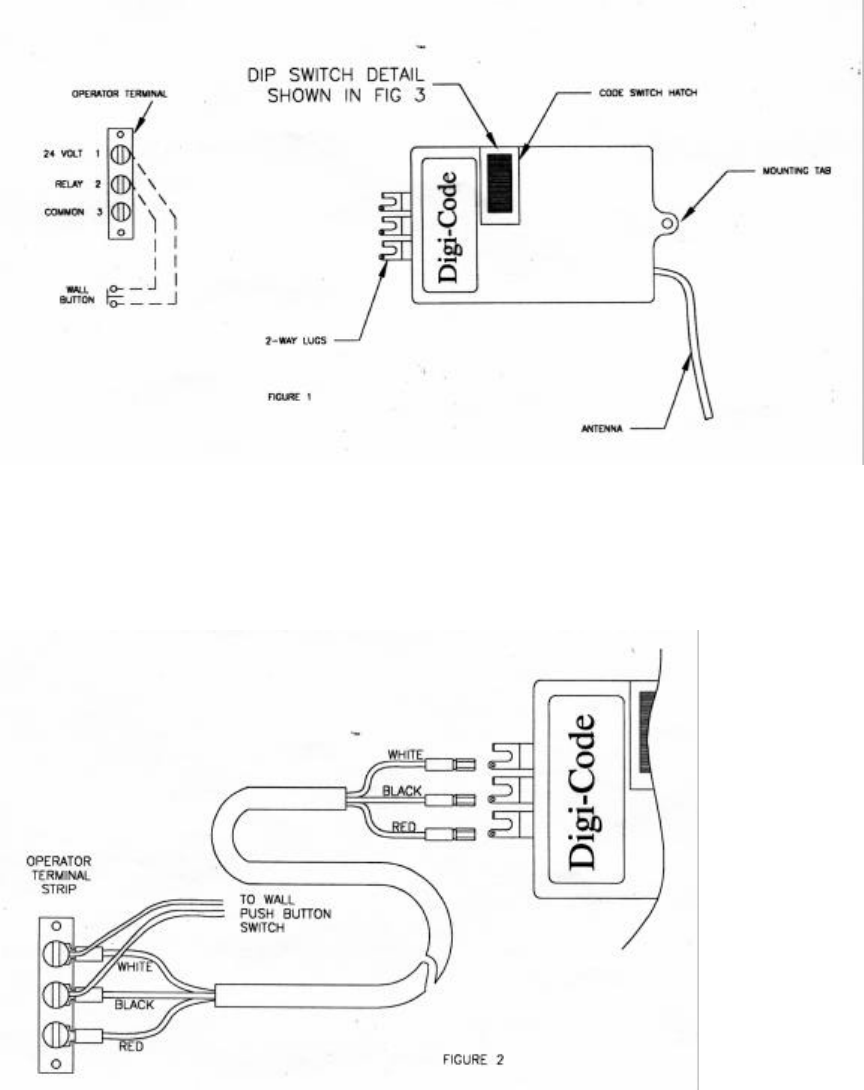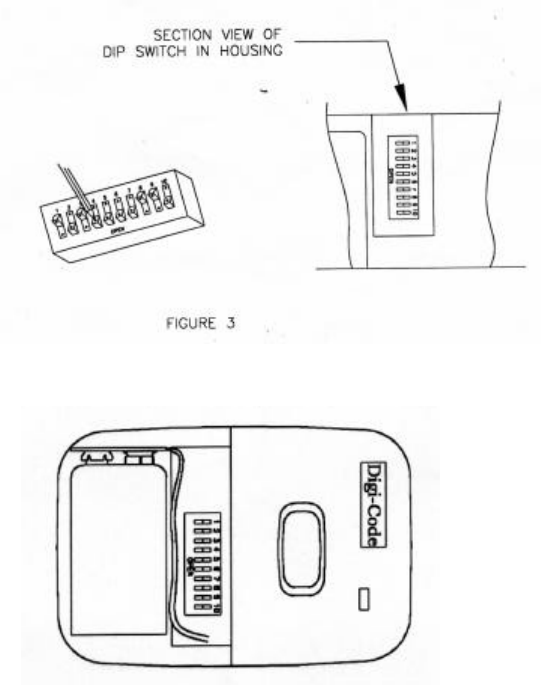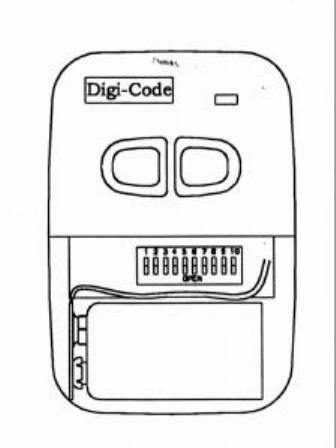Digi Code HC-DIGICODE User Manual
Digi-Code Inc Users Manual
Contents
- 1. installation instructions for the receiver
- 2. In preparation
installation instructions for the receiver

Installation Instructions
Garage Door Opener Radio Controls
Model 5010 (300 mHz) \ 5012 (310 mHz) Single Button Transmitters
Model 5020 (300 mHz) \ 5022 (310 mHz) Dual Button Transmitters
Model 5190-01 (300 mHz) \ 5190-02 (310 mHz) Receivers
WARNING:
•• Disconnect operator power before any installation or repair
•• Always wear safety glasses
Your Digi-Code radio controls are designed specifically to remotely control a garage
door opener from within an automobile and to give years of trouble free service without
adjustment. Because all radio controls are set with the even numbered switches in the
“ON” position when they leave the factory, it is recommended that a different code
be selected and set at the time of installation. Please refer to the “Setting the Code
Switch” section for instructions. The radio frequency (RF) portion of the controls,
however, are tuned to standard frequencies and are thoroughly tested at the factory. This
permits the addition or replacement of either the transmitter or the receiver by specifying
the Model number and the RF frequency designated on the identification label. RF
adjustments are not needed nor should any be attempted.
RECEIVER INSTALLATION
The receiver is designed to mount directly to the operator. It can be remotely installed if
the operator terminal strip is not accessible, or if the power for the receiver is not
obtainable from the operator. To direct mount the receiver, simply loosen the terminal
screws on the operator and insert the two-way lugs from the receiver under the screw
heads along the wall button wires, and tighten the screws ( See Figure #1)
Place the antenna (a 10 inch black wire ) in a vertical position as far from any metal as
possible.

For remote installation the receiver may be mounted near the operator head on a joist or
the ceiling by using the mounting tab. Order Model 5192-06 adapter, which permits
connection between the operator terminal and the two-way lugs on the receiver.
Slip on connectors at one end of the adapter connect to the flat side of each spade lug on
the receiver, and the spade connectors at the other end connect to the operator terminal.

Connect wires as follows:
(a) White wire to terminal “1” or “24v”
(b) Black wire to terminal “2” or “Relay”
(c) Red wire to terminal “3” or “Common” ( Radio Power )
(d) Connect push button wires to terminal “1” and “2” (See Figure #2)
Where power for the radio receiver is not available from the operator order a Model
5192-01 power transformer adapter for connection between the operator and the remote
receiver.
SETTING THE ( “RECEIVER” ) CODE SWITCH - TO WORK WITH MODEL
5010 AND MODEL 5012 SINGLE BUTTON TRANSMITTERS
Use your finger to slide the “code switch hatch” from the receiver for access to the code
switch. On the transmitter the entire front lower half of the case ( “ the battery hatch” ) is
removeable. Use a coin or the curved end of the visor clip to disengage the lower half of
the transmitter front. This will expose both the code switch and the battery compartment
(See Figure #3).
Model – 5010 (300mHz) or 5012 (310mHz)

Set both code switches to the code of your choice, being sure both are set the same
since a different setting of just one switch will prevent operation. The digital code is
determined by the position of the 10 small switches numbered 1 through 10 located in the
receiver and the transmitter. Any combination of “on” or “off” positions can be selected
by using a pencil or a pen. (Note: The switches are in the “on” position when the switch
is depressed toward the number.) See Figure #3 above.
Once the codes have been set, check operation and reinsert the hatches.
SETTING THE ( “RECEIVER” ) CODE SWITCHES - TO WORK WITH
MODEL 5020 AND MODEL 5022 DUAL BUTTON TRANSMITTERS
Use your finger to slide the “code switch hatch” from the receiver for access to the code
switch. On the transmitter the entire front lower half of the case ( “ the battery hatch” ) is
removeable. Use a coin or the curved end of the visor clip to disengage the lower half of
the transmitter front. This will expose both the code switch and the battery compartment.
See Figure #3 (Receiver) above and Figure #4 (Dual Button Transmitter) below.
Figure #4
Model – 5020 (300mHz) or 5022 (310mHz)
Before setting the receiver code switches, you will need to set the transmitter code switch
on your model 5020 or 5022. We strongly suggest that you change the code from the
factory setting to provide security for your own system, and to eliminate interference with
neighboring systems.
SETTING THE TRANSMITTER CODE SWITCH – MODEL’S 5020 & 5022
On the transmitter the entire front lower half of the case ( “ the battery hatch” ) is
removeable. Use a coin or the curved end of the visor clip to disengage the lower half of
the transmitter front. This will expose both the code switch and the battery compartment
Once you have done this, locate the code switch and set code switch positions 1 through
9 to your personal code scheme ( THE 10TH POSITION SWITCH MUST BE SET IN
THE CLOSED POSITION “ON” ). We strongly urge that several coding schemes be
avoided: ALL ON; 2,4,6,8,10, ON. These positions are similar to our or other
manufacturers test positions, or are frequently used.
SETTING RECEIVER #1 (WORKS WITH LEFT BUTTON ON TRANSMITTER)
Use your finger to slide the “code switch hatch” from the receiver for access to the code
switch. Set the receiver code switch positions 1 through 9 to match the transmitter code
switch. Then make sure that the 10th position switch on receiver #1 is set in the
closed position “ON”. The left button on the transmitter should now operate this
receiver.
Once the codes have been set, check operation and reinsert the hatches.
SETTING RECEIVER #2 (WORKS WITH RIGHT BUTTON ON TRANSMITTER)
Use your finger to slide the “code switch hatch” from the receiver for access to the code
switch. Set the receiver code switch positions 1 through 9 to match the transmitter code
switch. Then make sure that the 10th position switch on receiver #1 is set in the open
position “OFF”. The right button on the transmitter should now operate this receiver.
Once the codes have been set, check operation and reinsert the hatches.
CAUTION: Any changes or modifications in intentional or unintentional radiators which
are not expressly approved by Digi-Code Inc. could void the users authority to operate this
equipment. This applies to intentional and intentional radiators certified per part 15 of the
FCC rules and regulations.
DIGI-CODE, INC.
307 ROBBINS DR. • TROY, MICHIGAN 48083
(248) 589-3645
03/01/00